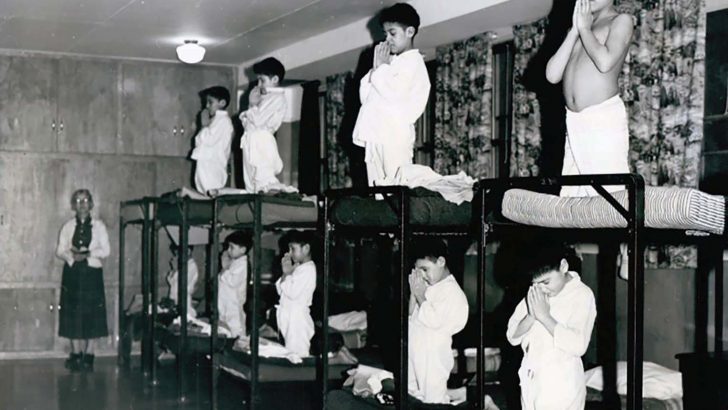The day might not be far off when protesters invade Irish churches, writes David Quinn
Eight Catholic churches in Canada have been burnt by arsonists in the last few weeks and in some cases totally destroyed. Ten churches were vandalised in the province of Alberta on one day alone last week.
The attacks are almost certainly a response to the discovery of hundreds of bodies at two former residential schools for indigenous Canadians run by the Catholic Church.
A policy existed in Canada lasting from 1867 until 1996 aimed at assimilating children from the native peoples (who we once called ‘Indians’) into mainstream Canadian society.
It was actually a form of cultural genocide in that the aim was eradicating the native culture of these people – now collectively called the ‘First Nation’ – not just their religion, but all of their customs and even their language.
Over that 129 years, about 150,000 children passed through the doors of these places and at least 4,500 died in them, although probably a lot more than that.
They were often extremely poorly resourced and badly run and disease was rampant in the days before antibiotics and vaccinations. The dead were buried in huge collective plots. The picture is not unlike the institutions here and elsewhere.
There was also widespread physical and sexual abuse.
Some of the children were of mixed race, and therefore could be rejected both by native Canadians and white Canadians.
Travellers
The policy, introduced by the Canadian government, was equivalent to Ireland deciding that Travellers would have to be assimilated into mainstream Irish society, and therefore their children would need to be removed from their families and raised in institutions.
Canada is, or was, a majority Protestant country, aside from the French parts, like Quebec. It is now an extremely secular country.
Although Catholicism is a minority religion in Canada, and always has been, about 60% of the institutions were run by the Catholic Church, and most of the rest by various Protestant organisations.
The non-Catholic institutions also have a tragic history.
The Catholic Church ran a majority of the residences for indigenous Canadian children because the religious orders had the personnel to do so.
When the discovery of hundreds of bodies on the grounds of two former institutions were found recently, there was outrage in Canada. It is almost certain that many more will be found at every other institution where they go looking. There are calls to do precisely this.
If outrage is understandable, violence is not. Most of the churches have been burnt down on First Nation land. But the people most disgusted by these acts are mainly other indigenous Canadians.
One of the churches was a wooden structure, built over a century ago on Chuchuwayha Indian Reserve number 2 by First Nation people who went to enormous lengths to do so.
They would then come from miles around to attend Mass there.
Carrie Allison, an elder who helped to maintain the church, told reporters: “The church meant so much to all of us, especially our ancestors. When your hurt turns to rage it is not healthy for you or your community.”
Another leader, Chief Keith Crow told public broadcaster CBC after being told another church was on fire: “I’m angry. I don’t see any positive coming from this and it’s going to be tough.”
Catholics in his community are very upset about the blaze, he said.
Happy
Some other Canadians are happy, however. A Canadian comedian who has over 700,000 followers on Twitter, said on the social media platform: “I hate Christianity in general but I REALLY hate Catholicism so seeing those Canadian churches on fire makes me feel all fuzzy inside”.
This received thanks or ‘likes’. Similar sentiments were expressed on Irish social media.
While the Catholic Church was the big target of attack, there were other targets as well. For example, two Anglican churches were burnt and one completely destroyed, although they might have been mistaken for Catholic churches.
One of the vandalised churches in Alberta was an African Evangelical Church.
Statues of Queen Victoria and Queen Elizabeth II were also vandalised. It was Canada Day on July 1, and like Independence Day in the US, it is now seen by some as an occasion of shame because of how native peoples were treated, plus the legacy of slavery.
The question arises: could attacks happen here like in Canada? There is certainly plenty of public anger and it doesn’t take much to ignite it. There is increasing militancy in society generally speaking and acts of violence can have a copycat effect.
Churches in Poland were recently invaded by pro-abortion protestors after a law was passed banning abortion on the grounds that the baby suffered from a disability like Downs Syndrome, and in parts of South America, including Chile and the Pope’s native Argentina, there have been many attacks on churches, including arson.
Plenty of churches in Ireland have been vandalised in recent years. Some of the attacks seem to have had an occult motivation, but none so far seems to have been political in nature.
Referendum
On the other hand, during the abortion referendum, pro-repeal campaigners would sometimes picture themselves in repeal sweaters alongside Catholic symbols.
The cross at the top of Carrauntoohil was cut down a few years ago and many think it was an act of protest against the Church because of the degree of motivation involved.
Don’t rule out the situation becoming worse. The day might not be far off when protesters invade churches in this country, even during Mass, as has happened elsewhere. We must fervently wish nothing like this ever happens here, but we can no longer rule out the possibility.


 David Quinn
David Quinn Indigenous boys pray on bunk beds in a dormitory at the Bishop Horden Memorial School,
a residential school in the indigenous Cree community of Ontario in 1950. Photo: CNS
Indigenous boys pray on bunk beds in a dormitory at the Bishop Horden Memorial School,
a residential school in the indigenous Cree community of Ontario in 1950. Photo: CNS 